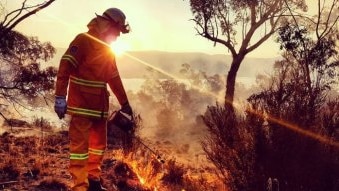Leon Compton
Could more fuel reduction actually make things harder to manage, David?
David Lindenmayer
Yes, it can. There are places where a landscape is burnt and then the regeneration after those fires actually leads to what we call disturbance stimulated flammability. Now that’s going to be a barbecue stopper of a turn, I’m sure. But the reality is that many ecosystems respond by regrowing or re-sprouting and there’s a period where that vegetation is more flammable and we see that after logging, after thinning and in some cases also after prescribed burning.
Leon Compton
Right, are these happening and I’ve noticed you’ve done significant research on this. Are those, is this research applied to the sort of landscapes that we have here in Tasmania?
David Lindenmayer
Absolutely, it applies very much to the tall wetter forests but also what’s happened is that people are seeing these kinds of things happening in drier forests and woodlands such as in south-western Western Australia. Interestingly, problems with disturbance stimulated flammability are now being seen in western North America, in central North America, South America, New South Wales, Victoria, elsewhere. So it’s it’s not an uncommon problem and what it means is that we need to rethink where we do prescribed burning. It doesn’t mean we throw it away, it means that we do it better where it matters, which is where to protect people and property and the data on house loss shows that prescribed burning does make a difference but it’s not a particularly huge one and it needs to be done very frequently and very close to where people live and property exists.
Leon Compton
Very close to where people live, so sort of abutting the littoral, the area between where people are actually living, the back fence if you like, and the bushland that abuts that.
David Lindenmayer
That’s correct, that’s correct and we need to be aware that it’s effectiveness isn’t huge but it is what we call statistically significant but that effect size doesn’t last for very long, around about three to five to seven years. So what we’re likely to see then I think is the best way forward here is to have sacrifice zones that are close to where people live, several hundred meters, and then move away from this idea that we need to do these massive industrial prescribed burns in remote areas. That’s really counterproductive and it’s actually not a good use of public money.
Leon Compton
David, if you do fewer fuel reduction burns, so less of it across the landscape, what do you do instead? We know that the climate is changing, that there are more fires caused by things like dry lightning in the case of the west coast fires, there’ll be more of it into the future. So if you don’t do this, what do you recommend?
David Lindenmayer
Well, I think it’s really important to preface my response with a couple of other things. The first one is that the medical data suggests that more people are likely to die from smoke related respiratory issues than they are likely to die in a fire, a wildfire. So that’s an important part of the discussion here when you’re talking about people and property. The second thing is that remember that some of these ecosystems, when they’re burnt, when they regenerate, or when they’re logged and they regenerate, they have a prolonged period of elevated fire risk. So then the question that you asked is what do we do about this? Well the first thing is that we need to rethink where we do prescribe burning to make it much more strategic and tactical and much more cost-effective. The second thing we need to do is think about what is the total disturbance burden in some of our landscapes and where should we not be doing more fire given how much fire we’ve had in the past. And the third thing is we need to look at the fact that in many parts of Australia there’s been a huge program of prescribed burning and the reality is that we’re still seeing extensive fires across large parts of landscapes. So you know really the logic here is I bash my head against the wall 15 times and it still hurts. Maybe if I bash my head against the wall 30 times it might hurt less. So that means that we need to have a rethink about these kinds of strategies and look at what we call a relative risk reduction associated with with these practices and think about what other things we might be able to do. So for example at ANU where I work, the engineering people have been looking at remote technologies through drones for detecting fires quickly and then suppressing those fires quickly because the best time to tackle wildfires is when they’re small which is soon after there’s been an ignition.

